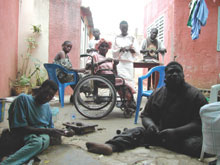Kit Griffin teaches in Senegal

Some of the participants in Kit Griffin’s ceramics program in Africa.
Photo: Kit Griffin
In January, 11 young students in the Senegalese fishing town of Mbour tried the art of ceramics for the first time. Their instructor was Kit Griffin, Concordia’s ceramics technician for the past 24 years.
The students belonged to a centre whose mandate was to provide training to the physically handicapped in order to stop them begging and give them a means to make an autonomous living.
“Almost everyone I worked with at the centre was handicapped, including the directors and teachers,” Griffin said. “In fact, when I got to Senegal, I was astonished to find out that around 20 per cent of the entire population is handicapped. There are a lot of people affected by polio, lots of amputations and birth deformities.”
Griffin was placed in Senegal by Canadian Executive Services Overseas (CESO), which connects volunteers to projects worldwide. She has been a member since 1992.
“A lot of CESO members are retired CEOs and business people,” she said. “Ceramics projects don’t come up that often.” That said, she found herself in Morocco for three months in 1992-93, setting up a ceramics project in a school. “That experience and the fact that I am a ceramist made me the perfect person for the Senegal job.”
Griffin’s students were seasoned in other crafts: the centre already ran facilities in tailoring, shoe making and repair, bookbinding, wood- and metal-work. “But they had no clay or materials, and they didn’t have a clue about pottery,” she said.
The first thing she asked was for the centre to find her someone who could locate them some clay. Enter Fatou who, like her mother and grandmother, was a traditional potter.
After some delicate negotiations, Fatou took Griffin 20 km inland to her childhood village. Miles from anywhere, in the middle of a field, she was shown a dried river bed. This would be the source of her clay.
Then the students began to make things. They tried pinch-pots, boxes, coils, slabs and burnishing techniques. Since there were no kilns, they used the technique of sawdust firing. “It’s also one of the first things we do with our students here at Concordia,” Griffin said.
Some students spoke Wolof, others Serrer, and a few spoke a little French. “If we couldn’t understand each other, we did a song and dance, but most of the time, what I was doing was very visual, so I could just show them.”
She encouraged the students to try new figures: sculptures, tiles, lizards, the baobab tree – things the students could market to tourists when they eventually set up shop. One man with only one arm worked on making a little Mbour-style fishing boat, with a tiny flag and seats. “This was the first piece to come out of the firing whole,” Griffin said. “It was a very moving moment.”
Griffin made nothing of the handicaps. Her main message throughout was that ceramics is group work. “It’s how we teach it here at Concordia. You can make a piece on your own, but there’s a lot of work you have to do together, like preparing the clay, firing and watching the pieces.”
The next step would have been to track down some oxides for decorating the pieces, but the project was only three weeks long. Griffin said she could easily have stayed another week.
“I’m a little worried as to how they will manage now. I’d like to go back in a year and see how they’re doing.”